Welcome back to my garden after my holiday trip to Cornwall and Devon. My holiday reading was Stephen Fry’s ‘Mythos’ in which he retells the dramatic tales of capricious gods and mortals as they navigate envy, love, lust and loss in ancient Greece.
Reading these tales has reminded me how many geological, meteorological, zoological and botanical features of the world the greek myths sought to explain. The male Chaffinch has a pinky red breast because the jealous goddess Hera strangled her messenger bird almost to the point of death whilst interrogating him for information about her philandering husband, Zeus. The Sahara desert is a permanently scarred strip of dry sand as Apollo allowed his supposed son Phaeton to drive the sun chariot across the world one day. The feckless inexperienced lad drove too close to the earth as he crossed North Africa hoping to wave and show off to his friend and lover below.
The stories are so rich and evocative and I’ve enjoyed every one but it’s the stories which have given name to plants that have interested me most. The myths give name to so many well known plants, Acis, Agave, Asclepius, Daphne, Narcissus and Hyacinth among them. Whilst walking my garden so many are brought to mind and I am spotting more and more plants whose names have an ancient greek derivation or meaning.
So often we refer to a plant’s latin name as shorthand for the botanical name and yet many of these originated not in latin, but in ancient Greek – either reaching us directly or through latin bastardisation of original Greek words.
Here are six of my favourite ancient Greek related plants – starting with Persephone’s descent into Hades. Autumn is approaching…
Persephone’s Path
We’ve all felt the chill in the air as August turned to September and summer slipped away. I haven’t given up hope of an Indian summer but we all know winter won’t delay forever.
Persephone was the beautiful daughter of Demeter, goddess of crops and fertile soil. Hades, god of the underworld, abducted Persephone, emerging from a crack in the earth and descending back underground, the earth closing over without a trace. A devastated Demeter combed the world in search of her beloved daughter. In her grief plants withered and crops failed. Starvation took hold amongst the mortals, alarming the gods of Olympus.
Zeus discovered that Hades had captured Persephone and sent Hermes to bring her home. Hades, mad with love for Persephone knew he had no choice but to let her go but negotiated a final day with her in the underworld. He fed her six pomegranate seeds knowing that once food had been consumed in Hades, someone’s presence could never be permanently removed. In this way he ensured that Persephone would return to him for six months of the year – one month for each seed – during which winter would preside above. On her release each year spring and summer would return.
When I saw these precious pink cyclamen hederifolium flowering, as they do each autumn, I thought of Persephone slowly descending to Hades down a flower edged path as autumn slips towards winter. This patch will spread and I think I’ll plant some autumn flowering Colchicums to light the pathway some more.
Cyclamen hederifolium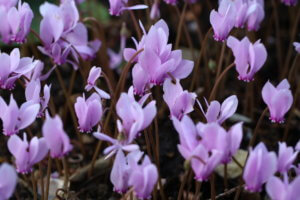
The name cyclamen has its origins in ancient Greece. The latin name cyclaminos is thought to derive from the ancient greek word kuklos meaning circle. There is little in the soft pink flowers to bring circles to mind but look closely as the flowers pass over and you will how the stems contract into neat circular spirals, each with a seed pod at the end.
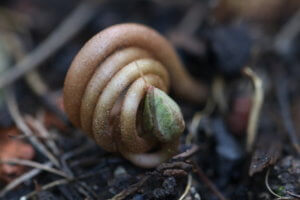
Helianthus – Perennial sunflower
The immortal greek gods formed unions with fellow gods, nymphs and mortals to spread their genetics and influence across the globe. Read the Greek Myths and a confusing labyrinthine network of family connections reveals itself.
Helios was the god of the sun, taking the reigns from Apollo (God of sun and light) to drive the sun in its chariot from east to west each day. Helios’ wikipedia page lists his consorts as “many” including Clymene, Klytie, Perse, Rhodos and Leucothea and his children as many more still including The charities, possibly Phaeton, Aeetes, Circe, Perses, Pasiohae, Heliadae, Heliades, Phaethusa and Lampetia.
Helios also gives his name to sunflowers – Helianthus and I was interested to learn that the perennial species I grow in my garden are often used in plant breeding to form new annual varieties, a modern day spreading of genetics of which I’m sure the gods would approve.
I rejoice in the tall yellow perennial varieties in my garden, their flowers so reminiscent of the burning sun. 
Protea cyranoides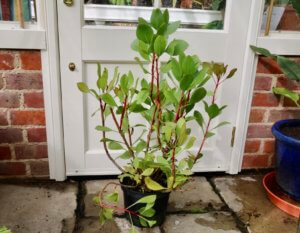
Behold my latest plant purchase – from Trevenna Cross nurseries in Cornwall -a longed for King Protea, the national flower of South Africa.
The god Proteus was son of Okeanos and Tethys and was known to have great powers of prophesy. He didn’t enjoy his status as a prophet and tried to evade those seeking guidance on their fates by shape-shifting into numerous different forms and disguises.
It is thought that the Protea flowers were named as such as they come in a huge array of shapes and sizes. Here are two pictures from the 2019 Chelsea Flower Show stand from Kirstenbosch Botanic Gardens to illustrate the point.
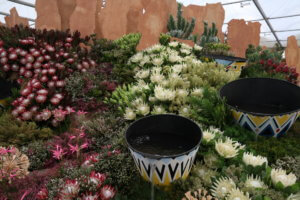
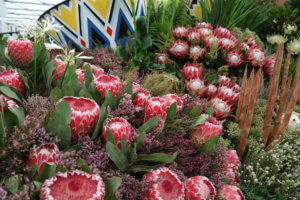
I once grew a protea from seed but despite coming from a packet clearly labelled Protea cyranoides it turned out to be something else entirely. I think it may be a leucadendron of some sort but I’m yet to be sure. Maybe the god Proteus is playing tricks and has shape shifted my protea for me.
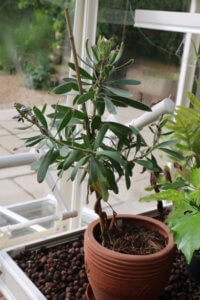
Hedychium gardnerianum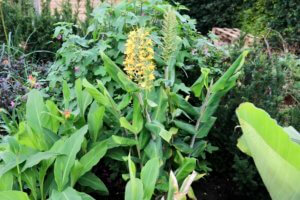
This addition to my tropical garden has been bursting out of its pot for a couple of years. Rejoicing in its liberation from the pot, it has burst forth this year into beautiful sweet-smelling blooms.
The name Hedychium derives from the ancient Greek word hedys meaning sweet and chios meaning snow, a reference to the plant Hedychium coronarium with its sweet white flowers.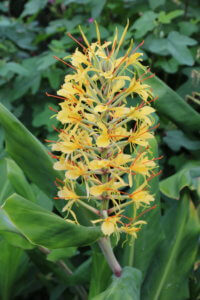
Gardnerianum has an altogether more zingy yellow and orange colouring and I’m delighted to welcome it to my garden having seen something similar in huge clumps two years ago at Glendurgan Garden in Cornwall. I’m assuming they’re hardy down there but I’m not taking the risk with mine. I’ve fallen for it as a greek god for a nymph and will be cossetting it over winter in the greenhouse.

Nymphaea – Water Lilies
Water nymphs, after whom water lilies are named, appear frequently in the greek myths. Many an illicit frolic appears to take place beside water and many a greek hero is descended from gods consorting with attractive water nymphs.
My pond garden has evolved well this year to create a place any god would feel happy to frolic, whereas I’m content to just sit there and ponder.

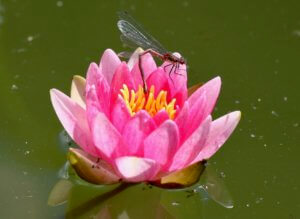
This seasonal diary is part of a weekly link-up of garden bloggers from around the world, called Six on Saturday. For more information and links to other blogs crammed with gardening activity, check the blog of host The Propagator.

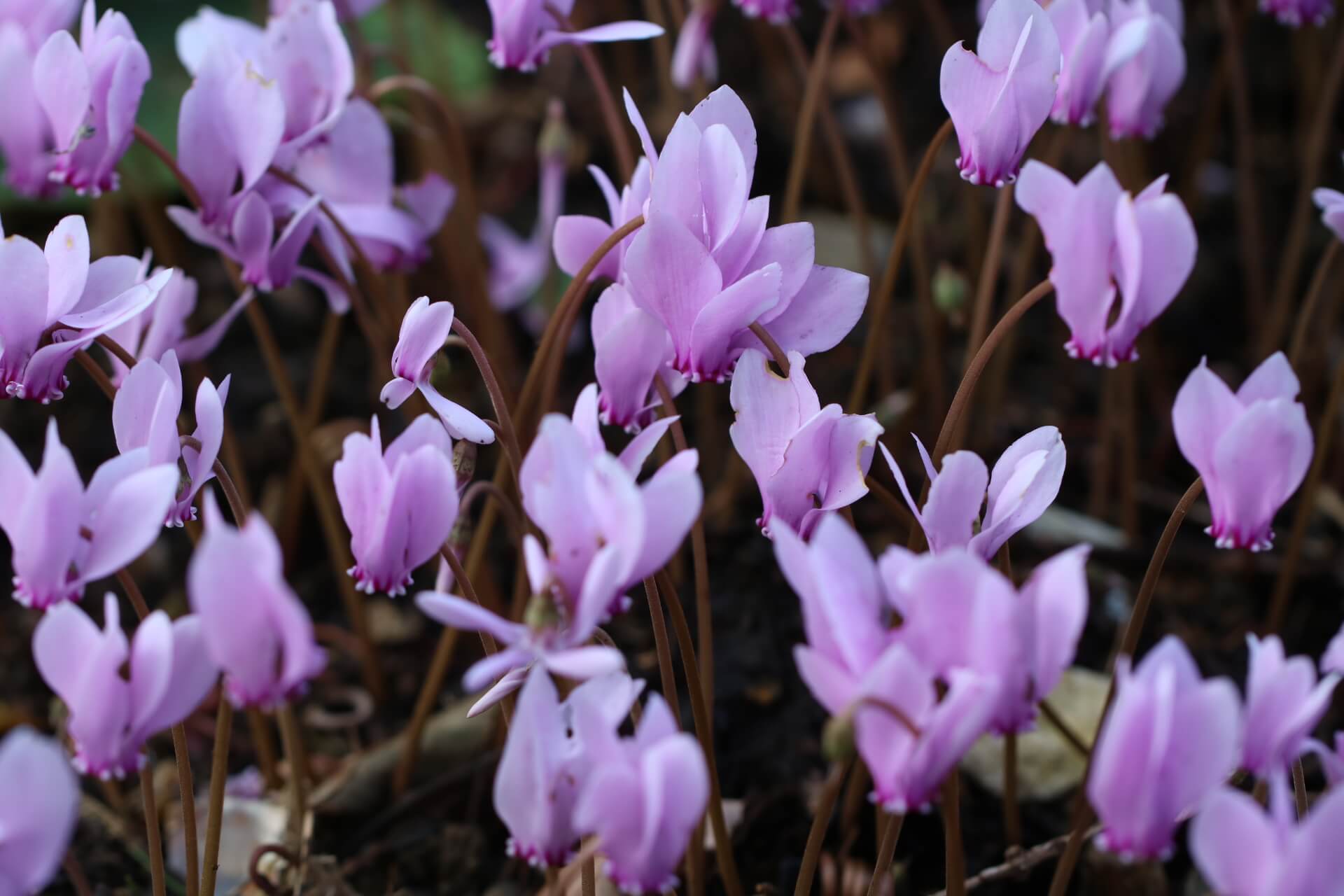



Beautiful cyclamen.
They sure are Barbara and are beginning to spread about too. A glorious plant for this time of year.
I enjoyed reading your post and the stories associated with plants in your garden.
Thanks Noelle.
That was a good read and educational too – I think I might do better should a Greek Mythology question crop up on The Chase! Your pond is looking great.
Ah the Chase – I sometimes watch that whilst cooking the family supper. I’ll smile next time there’s a myths question for sure. I’m really happy with the pond. The plants are all doing great. The only thing that’s lacking are frogs and newts but I’m told they’ll arrive one day…
An interesting and enjoyable post
Thanks so much Linda. I could have written about so many stories from the myths and their links to plants in my garden. They’re everywhere I look!
Superb Six! We can see that you enjoyed reading this book and sharing this historical epic with us through your Six. The photos are gorgeous (this cyclamen !!) and good luck with the protea
Thanks Fred. I so hope to get a flower one day on the protea. I so enjoyed reading this book, especially the tale of Persephone. It almost makes me relaxed about the winter ahead…
Wonderful!
Thanks Lisa – so glad you enjoyed reading it. My head is so full of the myths I see signs of them everywhere!
What a stunning garden you have. I did Latin as a young thing and loved the stories of the gods and goddesses. Very interesting to connect them to the flowers albeit the Greek versions. A few little cyclamen have appeared this week beside the brown garden bin at the bottom of the garden. I was going to include them next week if they are still flowering. Interesting Six-on-Saturday.
Hi Granny – So lovely that the cyclamen are prettifying your bin area and I look forward to seeing your pics next week.
Excellent recap of some favorite garden-related myths, Katharine. Consorting with nymphs, indeed!
Some of the myths are rather saucy for sure!
I loved that book, must read it again. Plant Heritage have a database system for recording National Collections; it’s called Persephone. I’m gradually putting the Mt Edgcumbe Camellia collection onto it. It’s their second shot at a database, the first was called Demeter.
Hedychium gardnerianum is a species I’ve only seen growing outdoors in the Helford River gardens, it must be pretty borderline even down here. The orange one in the picture below it is almost certainly ‘Tara’, which is bone hardy.
Hi Jim, so interesting that the database is called Persephone and sounds like your doing great work logging the Camellias. I think you’re right that the Glendurgan pic must be of’Tara’. Now I’m tempted to source some of those as I really like the spicy orange ad the hardiness is appealing!
I have a copy of Greek Myths by Robert Graves, which I’m ashamed to say I have never read. I’ll have to dig it out.
The Protea should be wonderful, though I assume it will need to be kept in the heated part of your greenhouse?
Hi Hortus. Yes I’ll probably keep it in the heated area over winter. I need to read up on how to care for it!
An incredibly interesting post. I loved the story of Persephone and I’ll see Cyclamen, and the many plants you mentioned, in a different light from now on.
The lily pond and its surrounding borders is a beautiful area.
Thanks Catherine – I’m so glad to have brought these stories to you. You can probably tell how much the book has got me thinking and seeing my plants and garden in a new light. It’s so great to be enlivened in this way and brought me bouncing back home from holiday.
What a most fabulous and interesting post. I love all the Greek myth connections with flowers. Echinacea is another one, derived from the Greek word (ekhinos), meaning “sea urchin” and Anemone is derived from the Greek word anemoi, which in English means “winds” hence the common name windflower. Hedychium gardnerianum grows outdoors in the Trengwainton walled gardens where it is very sheltered.
Hi Jude – you’ve highlighted some more great plants there and I can completely see why Echinacea gets its name from Sea Urchin. Isn’t language wonderful?! I do so envy the Cornish climate but equally al lucky to have me greenhouse with heated section to coax my ginger lilies through the Chiltern winter. It can be very cold and damp here in the hills. Some years ago the temperature dropped to -17 in nearby Chesham so I’ll be taking no chances with my tender perennials…